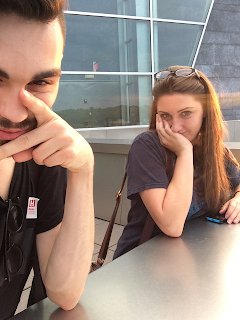Taylor Vance

Liu, Hung. Pullman. 2004. Oil on Canvas. Photographed at the Hunter Museum of American Art, Chattanooga.
Hung Liu's massive and powerful Pullman was the first piece to strike me. When the central theme of an artist's work is oppression, their work voices the personal adversities the artist has faced. Hung Liu is no exception, as Liu's work depicts her childhood under Mao Zedong's Communist state in the 1950's and 1960's in the countryside of China. Pullman is an oil on canvas painting which depicts two low-income, working class men, perhaps father and son, straining and struggling to complete the task of pulling a boat upstream. It is blatant that the weight of the boat is weighing the men down, which is symbolic of Mao's regime. Oppression derives from the concept of being weighted down; therefore, as Communism was being implemented across the People's Republic of China, the artwork during this period was often depicted as such.
I couldn't help but feel an overwhelming sense of emptiness when gazing at Pullman. The monochromatic color scheme of the two men gives the painting a melancholic essence. While the unfinished background offers a feeling of incompleteness, the labored men tugging the rope along to the right side of the composition with their backs turned shows the viewer their hopelessness while showcasing a captured moment of their daily lives. Despite the fact that the painted models are strong and in-shape, the work suggests that the men are vulnerable and weak in spirit because they have been subjected to oppression and inhumane treatment because of Communism.
Massive brushstrokes beginning from the front of the men create a watercolor-like effect, visibly making the subjects appear upset. It is a powerful experience observing two men cry because viewing an older male figure sobbing goes against a myriad of gender stereotypes in most cultures. However, blogger Michael Grant suggests that the artwork, "combines in bravura fashion representational figures (evoking her Soviet Realist training in China) with drips, circles and energetic swirls of paint." While Grant makes a valid point, I believe that the men are crying because they are mentally directionless. The eerie Pullman characterizes the daily lives of people of poverty in China under a terrorizing government, providing a sense of empowerment because of the worker's will. The men, soaked in their own tears, keep pulling forward, solidifying their strength and inspiring will to live.
Next up is Hans Hofman's Scintillating Blue 38-30, a non-objective art piece that is equally as chaotic as it is stunning. The painting commands attention through its application of thick brush strokes and various colors to create a complicated and hectic composition. I find this painting compelling through its frantic brushstrokes. Abstract Expressionism conveys a message by forcing the viewer to look at a piece of art, eradicate any preconceived notions about what art is, and learn to appreciate work based on basic elements of art rather than whether the image "looks like something". Hofman brilliantly smears the primary colors throughout the canvas. The artist does not allow himself to compromise his style to make something appear photorealistic, rather his work stemmed from the way he felt in a moment.
I was fairly eager to find this work, as Abstract Expressionism is one of my favorite art periods. Artists like Hofman, de Kooning and Pollock challenged the typical standards of art and created work based on their emotions and interests through texture, dripping, scribbles, and other techniques. We often think that art should be representational, but artwork like Scintillating Blue 38-30 provides a sense of laid-back ease with details that scream out loud.
Both artists used massive brushstrokes and were obviously both influenced by Jackson Pollock to create their works; however the end results drastically differ in each painting. Liu uses a drip style that Pollock pioneered and Hofmann used personal emotion just as Pollock poured his heart out onto a canvas. While Pullman is a gray, monochromatic piece that depicts the lack of joy in the men's lives, Scintillating Blue 38-30 uses bright primary colors to bring joy into the viewer's eyes. Each painting gives the viewer a rush of emotion- one piece conveys sadness, while the other conveys the joie de vivre.

Hofmann, Hans. Scintillating Blue 38-30. 1956. Oil on canvas. Photographed at the Hunter Museum of American Art, Chattanooga.

No comments:
Post a Comment